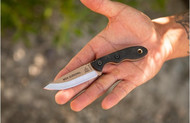Consider These Tips When Selecting a Survival Knife
Jan 13 2023 - 7:47
Many different survival and outdoor enthusiasts will have extremely varied opinions regarding the finest survival knife when you start a discussion about it with them. When it comes down to it, everyone has their own preference for a survival knife based on past experience and the kinds of tasks they expect to face in the wilderness.
In the event that you find yourself stranded in the wilderness, a high-quality survival knife is an essential item to have on hand. This knife may be used for everything from building a shelter to skinning game to splitting firewood to cutting rope to opening cans. Before you spend your money, know what to look for.
Be Familiar with Different Kinds of Knives
Knives can be categorized into a variety of groups. Fixed and folding blades are two simple categories.
Knives with fixed blades are usually stronger and more suited for laborious tasks, while folders make excellent pocket knives. Fixed blades are preferable for survival knives and bushcraft instruments, while folders are good for EDC pocket knives.
A little, fixed pocket knife would be appropriate if all you needed it for was cutting twine and apples. The TOPS Knives’ Mini Scandi Survival, which is excellent for fishing and general use, is preferred by many bushcrafters. You can put it in your pocket and go around with ease because it is compact and simple to carry.
Despite what you see on TV, a survival knife should be simple.
Always put function before fashion. Performance should be your top concern because it depends on several tried-and-true key elements.
Key Characteristics of an Effective Survival Knife
Adequate Size
Is size important? Yes, but not always. When dealing with intricate jobs like dressing small game or carving precise traps, a blade that is too large can be cumbersome and inefficient.
On the other hand, harder jobs like chopping and batoning are difficult for a little blade to handle well.
The Ontario RAT-5, 4.4" Black 1095 Fixed Blade, Wilderness Survival Knife, for instance, is a 10.5 in. knife from our collection that can unquestionably do the job in the woods. It was intended to be a functional knife with minimal frills for doing serious work. It also offers remarkable durability and performance at an affordable price.
Fixed-Blade Is Your Best Bet
For everyday carry, a nice folding knife is ideal, but for survival situations, you'll need a fixed blade. A folding knife's joint is especially vulnerable to the kind of rigorous use your survival knife will get, which is why they aren't ideal.
You want a survival knife that can easily be used for cutting forcefully, stabbing, prying, and pounding. As a result, folding knives are not suitable for use in the context of survival.
By selecting a knife that is better suited for smashing, chopping, thrusting, prying, and vigorous cutting, you can reduce the chance that you'll lose or damage your primary survival tool.

Check out the Highland Hunter in Walnut Handle with Tribal Artwork by Winkler Knives from our collection for a pretty nice fixed blade. In addition to being used every day for normal use, this knife is designed to tackle all the tasks needed for a hunting expedition. With its fascinating tribal pattern and excellent walnut construction, the handle instantly gives you the appearance of being a true bushcrafter.
Look for a Full Tang Knife
Your survival knife needs to be FULL TANG in addition to having a fixed blade. Compared to partial tang designs, a full tang knife is far more durable.
If you need to pry something open or press the blade against something solid, you can't do either with a knife that only has a partial tang. If you need to pry something open or do some digging, the full-tang knife is your best bet.
A Solid Grip Matters
It makes no difference whether your knife handle is made of Micarta, glass-reinforced nylon, or a piece of moose antler. You must be able to grip it firmly and easily, whether it's dry or wet.
It's simple to concentrate on the blade and how to maximize its effectiveness, but keep in mind that you will frequently need to hold and utilize the survival knife in adverse weather conditions. When you use your knife to baton wood or loosen things, the handle will also receive a significant amount of abuse.
Hardness, toughness, and grip are the three main characteristics to consider in the survival knife's handle.
Each of us has our own preferred selection of survival equipment. The number of possible survival situations is greater than the number of available survival knives. Therefore, your preferred knife may not be the same as someone else's.
Whether you're at home or far from civilization, having a survival knife on you at all times is a smart idea in case of an emergency. Make sure the knife you're thinking about buying meets the bare minimum requirements for practicality and durability.
Check out our website to read more about the knives we discussed in this article.
